Postmodern architecture

Postmodern architecture began as an international style – the first examples of which are generally cited as being from the 1950s – but did not become a movement until the late 1970s[1] and continues to influence present-day architecture. Postmodernity in architecture is said to be heralded by the return of "wit, ornament and reference" to architecture in response to the formalism of the International Style of modernism. As with many cultural movements, some of Postmodernism's most pronounced and visible ideas can be seen in architecture. The functional and formalized shapes and spaces of the modernist style are replaced by diverse aesthetics: styles collide, form is adopted for its own sake, and new ways of viewing familiar styles and space abound. Perhaps most obviously, architects rediscovered past architectural ornament and forms which had been abstracted by the Modernist architects.
Influential early large-scale examples of postmodern architecture are Michael Graves' Portland Building in Portland, Oregon and Philip Johnson's Sony Building (originally AT&T Building) in New York City, which borrows elements and references from the past and reintroduces color and symbolism to architecture.
Postmodern architecture has also been described as neo-eclectic, where reference and ornament have returned to the facade, replacing the aggressively unornamented modern styles. This eclecticism is often combined with the use of non-orthogonal angles and unusual surfaces, most famously in the State Gallery of Stuttgart by James Stirling and the Piazza d'Italia by Charles Moore. The Scottish Parliament Building in Edinburgh has also been cited as being of postmodern vogue.
Modernist architects may regard postmodern buildings as vulgar, associated with a populist ethic, and sharing the design elements of shopping malls, cluttered with "gew-gaws". Postmodern architects may regard many modern buildings as soulless and bland, overly simplistic and abstract. This contrast was exemplified in the juxtaposition of the "whites" against the "grays," in which the "whites" were seeking to continue (or revive) the modernist tradition of purism and clarity, while the "grays" were embracing a more multifaceted cultural vision, seen in Robert Venturi's statement rejecting the "black or white" world view of modernism in favor of "black and white and sometimes gray." The divergence in opinions comes down to a difference in goals: modernism is rooted in minimal and true use of material as well as absence of ornament, while postmodernism is a rejection of strict rules set by the early modernists and seeks meaning and expression in the use of building techniques, forms, and stylistic references.
One building form that typifies the explorations of Postmodernism is the traditional gable roof, in place of the iconic flat roof of modernism. Shedding water away from the center of the building, such a roof form always served a functional purpose in climates with rain and snow, and was a logical way to achieve larger spans with shorter structural members, but it was nevertheless relatively rare in Modernist buildings. (These were, after all, "machines for living," according to LeCorbusier, and machines did not usually have gabled roofs.) However, Postmodernism's own modernist roots appear in some of the noteworthy examples of "reclaimed" roofs. For instance, Robert Venturi's Vanna Venturi House breaks the gable in the middle, denying the functionality of the form, and Philip Johnson's 1001 Fifth Avenue building in Manhattan (not to be confused with Portland's Congress Center, once referred to by the same name) advertises a mansard roof form as an obviously flat, false front. Another alternative to the flat roofs of modernism would exaggerate a traditional roof to call even more attention to it, as when Kallmann McKinnell & Wood's American Academy of Arts and Sciences in Cambridge, Massachusetts, layers three tiers of low hipped roof forms one above another for an emphatic statement of shelter.
Relationship to previous styles

A new trend became evident in the last quarter of the 20th century as some architects started to turn away from modern functionalism which they viewed as boring, and which some of the public considered unwelcoming and even unpleasant. These architects turned towards the past, quoting past aspects of various buildings and melding them together (even sometimes in an inharmonious manner) to create a new means of designing buildings. A vivid example of this new approach was that Postmodernism saw the comeback of columns and other elements of premodern designs, sometimes adapting classical Greek and Roman examples (but not simply recreating them, as was done in neoclassical architecture). In Modernism, the traditional column (as a design feature) was treated as a cylindrical pipe form, replaced by other technological means such as cantilevers, or masked completely by curtain wall façades. The revival of the column was an aesthetic, rather than a technological necessity. Modernist high-rise buildings had become in most instances monolithic, rejecting the concept of a stack of varied design elements for a single vocabulary from ground level to the top, in the most extreme cases even using a constant "footprint" (with no tapering or "wedding cake" design), with the building sometimes even suggesting the possibility of a single metallic extrusion directly from the ground, mostly by eliminating visual horizontal elements—this was seen most strictly in Minoru Yamasaki's World Trade Center buildings.
Another return was that of the “wit, ornament and reference” seen in older buildings in terra cotta decorative façades and bronze or stainless steel embellishments of the Beaux-Arts and Art Deco periods. In Postmodern structures this was often achieved by placing contradictory quotes of previous building styles alongside each other, and even incorporating furniture stylistic references at a huge scale.
Contextualism, a trend in thinking in the later parts of 20th century, influences the ideologies of the postmodern movement in general. Contextualism is centered on the belief that all knowledge is “context-sensitive”. This idea was even taken further to say that knowledge cannot be understood without considering its context. While noteworthy examples of modern architecture responded both subtly and directly to their physical context (analyzed by Thomas Schumacher in "Contextualism: Urban Ideals and Deformations," and by Colin Rowe and Fred Koetter in Collage City[2]), postmodern architecture often addressed the context in terms of the materials, forms and details of the buildings around it—the cultural context.
Roots of Postmodernism

The Postmodernist movement is often seen (especially in the USA) as an American movement, starting in America around the 1960s–1970s and then spreading to Europe and the rest of the world, to remain right through to the present. In 1966, however, the architectural historian Sir Nikolaus Pevsner spoke of a revived Expressionism as being "a new style, successor to my International Modern of the 1930s, a post-modern style", and included as examples Le Corbusier's work at Ronchamp and Chandigarh, Denys Lasdun at the Royal College of Physicians in London, Richard Sheppard at Churchill College, Cambridge, and James Stirling's and James Gowan's Leicester Engineering Building, as well as Philip Johnson's own guest house at New Canaan, Connecticut. Pevsner disapproved of these buildings for their self-expression and irrationalism, but he acknowledged them as "the legitimate style of the 1950s and 1960s" and defined their characteristics. The job of defining Postmodernism was subsequently taken over by a younger generation who welcomed rather than rejected what they saw happening and, in the case of Robert Venturi, contributed to it.
The aims of Postmodernism or Late-modernism begin with its reaction to Modernism; it tries to address the limitations of its predecessor. The list of aims is extended to include communicating ideas with the public often in a then humorous or witty way. Often, the communication is done by quoting extensively from past architectural styles, often many at once. In breaking away from modernism, it also strives to produce buildings that are sensitive to the context within which they are built.
Postmodernism has its origins in the perceived failure of Modern architecture.[3] Its preoccupation with functionalism and economical building meant that ornaments were done away with and the buildings were cloaked in a stark rational appearance. Many felt the buildings failed to meet the human need for comfort both for body and for the eye, that modernism did not account for the desire for beauty. The problem worsened when some already monotonous apartment blocks degenerated into slums. In response, architects sought to reintroduce ornament, color, decoration and human scale to buildings. Form was no longer to be defined solely by its functional requirements or minimal appearance.
Changing pedagogies
Critics of the reductionism of modernism often noted the abandonment of the teaching of architectural history as a causal factor. The fact that a number of the major players in the shift away from modernism were trained at Princeton University's School of Architecture, where recourse to history continued to be a part of design training in the 1940s and 1950s, was significant. The increasing rise of interest in history had a profound impact on architectural education. History courses became more typical and regularized. With the demand for professors knowledgeable in the history of architecture, several PhD programs in schools of architecture arose in order to differentiate themselves from art history PhD programs, where architectural historians had previously trained. In the US, MIT and Cornell were the first, created in the mid-1970s, followed by Columbia, Berkeley, and Princeton. Among the founders of new architectural history programs were Bruno Zevi at the Institute for the History of Architecture in Venice, Stanford Anderson and Henry Millon at MIT, Alexander Tzonis at the Architectural Association, Anthony Vidler at Princeton, Manfredo Tafuri at the University of Venice, Kenneth Frampton at Columbia University, and Werner Oechslin and Kurt Forster at ETH Zürich.[4]
The creation of these programs was paralleled by the hiring, in the 1970s, of professionally trained historians by schools of architecture: Margaret Crawford (with a PhD from U.C.L.A) at SCI-Arc; Elisabeth Grossman (PhD, Brown University) at Rhode Island School of Design; Christian Otto[5] (PhD, Columbia University) at Cornell University; Richard Chafee (PhD, Courtauld Institute) at Roger Williams University; and Howard Burns (M.A. Kings College) at Harvard, to name just a few examples. A second generation of scholars then emerged that began to extend these efforts in the direction of what is now called “theory”: K. Michael Hays (PhD, MIT) at Harvard, Mark Wigley (PhD, Auckland University) at Princeton (now at Columbia University), and Beatriz Colomina (PhD, School of Architecture, Barcelona) at Princeton; Mark Jarzombek (PhD MIT) at Cornell (now at MIT), Jennifer Bloomer (PhD, Georgia Tech) at Iowa State and Catherine Ingraham (PhD, Johns Hopkins) now at Pratt Institute.
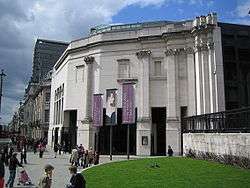
Robert Venturi was at the forefront of the postmodern movement. His book, "Complexity and Contradiction in Architecture" (published in 1966), was instrumental in opening readers eyes to new ways of thinking about buildings, as it drew from the entire history of architecture—both high-style and vernacular, both historic and modern—and lambasted overly simplistic Functional Modernism. The move away from modernism’s functionalism is well illustrated by Venturi’s adaptation of Mies van der Rohe’s famous maxim “Less is more” to "Less is a bore." The book includes a number of the architect's own designs in the back, including structures such as Guild House, in Philadelphia, that became major icons of postmodernism. He sought to bring back ornament because of its necessity. He explains this and his criticism of Modernism in his Complexity and Contradiction in Architecture by saying that:
Architects can bemoan or try to ignore them (referring to the ornamental and decorative elements in buildings) or even try to abolish them, but they will not go away. Or they will not go away for a long time, because architects do not have the power to replace them (nor do they know what to replace them with).
Venturi's second book, Learning from Las Vegas (1972) further developed his take on modernism. Co-authored with his wife, Denise Scott Brown, and Steven Izenour, Learning from Las Vegas argues that ornamental and decorative elements “accommodate existing needs for variety and communication”. Alex Todorow in one of his essays, A View from the Campidoglio, to that effect when he says that:
When [he] was young, a sure way to distinguish great architects was through the consistency and originality of their work...This should no longer be the case. Where the Modern masters' strength lay in consistency, ours should lie in diversity.
Postmodernism with its diversity possesses sensitivity to the building’s context and history, and the client’s requirements. The postmodernist architects often considered the general requirements of the urban buildings and their surroundings during the building’s design. For example, in Frank Gehry's Venice Beach House, the neighboring houses have a similar bright flat color. This vernacular sensitivity is often evident, but other times the designs respond to more high-style neighbors. James Stirling's Arthur M. Sackler Museum at Harvard University features a rounded corner and striped brick patterning that relate to the form and decoration of the polychromatic Victorian Memorial Hall across the street, although in neither case is the element imitative or historicist.
Aims and characteristics

The aims of Postmodernism, which include solving the problems of Modernism, communicating meanings with ambiguity, and sensitivity for the building’s context, are surprisingly unified for a period of buildings designed by architects who largely never collaborated with each other. These aims do, however, leave room for diverse implementations as can be illustrated by the variety of buildings created during the movement.
The characteristics of postmodernism allow its aim to be expressed in diverse ways. These characteristics include the use of sculptural forms, ornaments, anthropomorphism and materials which perform trompe l'oeil. These physical characteristics are combined with conceptual characteristics of meaning. These characteristics of meaning include pluralism, double coding, flying buttresses and high ceilings, irony and paradox, and contextualism.
The sculptural forms, not necessarily organic, were created with much ardor. These can be seen in Hans Hollein’s Abteiberg Museum (1972–1982). The building is made up of several building units, all very different. Each building’s forms are nothing like the conforming rigid ones of Modernism. These forms are sculptural and are somewhat playful. These forms are not reduced to an absolute minimum; they are built and shaped for their own sake. The building units all fit together in a very organic way, which enhances the effect of the forms.
After many years of neglect, ornament returned. Frank Gehry’s Venice Beach house, built in 1986, is littered with small ornamental details that would have been considered excessive and needless in Modernism. The Venice Beach House has an assembly of circular logs which exist mostly for decoration. The logs on top do have a minor purpose of holding up the window covers. However, the mere fact that they could have been replaced with a practically invisible nail, makes their exaggerated existence largely ornamental. The ornament in Michael Graves' Portland Municipal Services Building ("Portland Building") (1980) is even more prominent. The two obtruding triangular forms are largely ornamental. They exist for aesthetic or their own purpose.
Postmodernism, with its sensitivity to the building’s context, did not exclude the needs of humans from the building. Carlo Scarpa's Brion Cemetery (1970–72) exemplifies this. The human requirements of a cemetery is that it possesses a solemn nature, yet it must not cause the visitor to become depressed. Scarpa’s cemetery achieves the solemn mood with the dull gray colors of the walls and neatly defined forms, but the bright green grass prevents this from being too overwhelming.
Postmodern buildings sometimes utilize trompe l'oeil, creating the illusion of space or depths where none actually exist, as has been done by painters since the Romans. The Portland Building (1980) has pillars represented on the side of the building that to some extent appear to be real, yet they are not.
The Hood Museum of Art (1981–1983) has a typical symmetrical façade which was at the time prevalent throughout Postmodern Buildings.
Robert Venturi’s Vanna Venturi House (1962–64) illustrates the Postmodernist aim of communicating a meaning and the characteristic of symbolism. The façade is, according to Venturi, a symbolic picture of a house, looking back to the 18th century. This is partly achieved through the use of symmetry and the arch over the entrance.
Perhaps the best example of irony in Postmodern buildings is Charles Moore’s Piazza d'Italia (1978). Moore quotes (architecturally) elements of Italian renaissance and Roman Antiquity. However, he does so with a twist. The irony comes when it is noted that the pillars are covered with steel. It is also paradoxical in the way he quotes Italian antiquity far away from the original in New Orleans.[6]
Double coding meant the buildings convey many meanings simultaneously. The Sony Building in New York does this very well. The building is a tall skyscraper which brings with it connotations of very modern technology. Yet, the top contradicts this. The top section conveys elements of classical antiquity. This double coding is a prevalent trait of Postmodernism.
The characteristics of Postmodernism were rather unified given their diverse appearances. The most notable among their characteristics is their playfully extravagant forms and the humour of the meanings the buildings conveyed.
Subsequent movements
Following the postmodern riposte against modernism, various trends in architecture established, though not necessarily following principles of postmodernism. Concurrently, the recent movements of New Urbanism and New Classical Architecture promote a sustainable approach towards construction, that appreciates and develops smart growth, architectural tradition and classical design.[7][8] This in contrast to modernist and globally uniform architecture, as well as leaning against solitary housing estates and suburban sprawl.[9] Both trends started in the 1980s. The Driehaus Architecture Prize is an award that recognizes efforts in New Urbanism and New Classical Architecture, and is endowed with a prize money twice as high as that of the modernist Pritzker Prize.[10] Some postmodern architects, such as Robert A. M. Stern and Albert, Righter, & Tittman, have moved from postmodern design to new interpretations of traditional architecture.[3]
Influential architects
Some of the best-known and influential architects in the Postmodern style are:
- Joel Bergman
- Barbara Bielecka
- Ricardo Bofill
- Mario Botta
- John Burgee
- Charles Correa
- Peter Eisenman
- Terry Farrell
- Frank Gehry
- James Gowan
- Michael Graves
- Hans Hollein
- Arata Isozaki
- Helmut Jahn
- Jon Jerde
- Philip Johnson
- Edward Jones
- Hans Kollhoff
- Ricardo Legorreta
- Ernst Lohse
- Charles Moore
- William Pedersen
- César Pelli
- Boris Podrecca
- John C. Portman Jr.
- Paolo Portoghesi
- Antoine Predock
- Kevin Roche
- Aldo Rossi
- Carlo Scarpa
- Denise Scott Brown
- Robert A. M. Stern
- James Stirling
- Tomás Taveira
- Siavash Teimouri
- Robert Venturi
- Michael Wilford
- James Wines
- Eberhard Zeidler
Examples of postmodern architecture

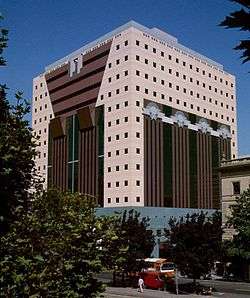
.jpg)





 The Harold Washington Library in Chicago, Illinois, by Hammond, Beeby & Babka, completed 1991
The Harold Washington Library in Chicago, Illinois, by Hammond, Beeby & Babka, completed 1991- 100 North Tampa in Tampa, Florida, by HKS, Inc. It was completed in 1992.
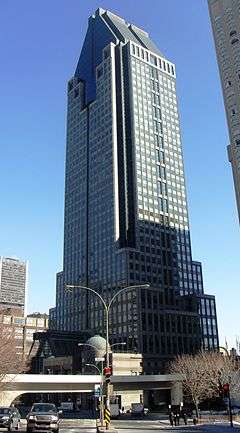 1000 de La Gauchetière, in Montréal, Canada, by Lemay & Associates, Dimakopoulos & Associates; completed 1992
1000 de La Gauchetière, in Montréal, Canada, by Lemay & Associates, Dimakopoulos & Associates; completed 1992
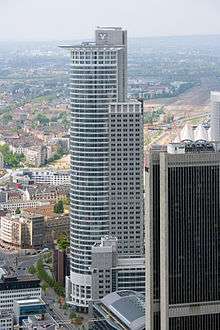





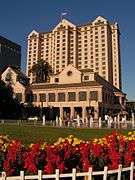 The Fairmont, San Jose CA. Completed 1987
The Fairmont, San Jose CA. Completed 1987- Marriott Marquis, San Francisco, CA. Completed 1989
| Postmodernism |
|---|
| preceded by Modernism |
| Postmodernity |
| Postmodern... |
| Criticism of postmodernism |
See also
- Neo-Historism, a reference style to historical architecture, emerged from Postmodernism. It attempts at creating more accurate references of historical architecture styles.
- Third Bay Tradition
- Charles Jencks
Notes
- ↑ http://jan.ucc.nau.edu/~twp/architecture/postmoderncom/
- ↑ Nesbitt, Kate (1996). Theorizing A New Agenda for Architecture: An Anthology of Architectural Theory 1965-1995. New York: Princeton Architectural Press. p. 294. ISBN 1-56898-053-1.
- 1 2 McAlester, Virginia Savage (2013). A Field Guide to American Houses. Alfred A. Knopf. pp. 664–665, 668–669. ISBN 978-1-4000-4359-0.
- ↑ Mark Jarzombek, “The Disciplinary Dislocations of Architectural History,” Journal of the Society of Architectural Historians 58/3 (September 1999), p. 489. See also other articles in that issue by Eve Blau, Stanford Anderson, Alina Payne, Daniel Bluestone, Jeon-Louis Cohen and others.
- ↑ Cornell University Dept. of Architecture website
- ↑ Heinrich Klotz, "The History of Postmodern Architecture", MIT Press, Cambridge Massachusetts, 1988
- ↑ Charter of the New Urbanism
- ↑ "Beauty, Humanism, Continuity between Past and Future". Traditional Architecture Group. Retrieved 23 March 2014.
- ↑ Issue Brief: Smart-Growth: Building Livable Communities. American Institute of Architects. Retrieved on 2014-03-23.
- ↑ "Driehaus Prize". Together, the $200,000 Driehaus Prize and the $50,000 Reed Award represent the most significant recognition for classicism in the contemporary built environment.. Notre Dame School of Architecture. Retrieved 23 March 2014.
References
- Postmodern Architecture: Restoring Context Princeton University Lecture
- Postmodern Architecture and Urbanism University of California - Berkeley Lecture
- Learning from Las Vegas: The Forgotten Symbolism of Architectural Form. Robert Venturi, Cambridge, MA: MIT Press, 1977 ISBN 0-262-22015-6
- History of Post-Modern Architecture. Heinrich Klotz, Cambridge, MA: MIT Press, 1998. ISBN 0-262-11123-3
External links
- About Postmodernism
- Postmodern architecture at the archINFORM database.
- Gallery of Postmodern Houses
- Post Modern Architecture at Great Buildings Online
| Wikimedia Commons has media related to Postmodern architecture. |
